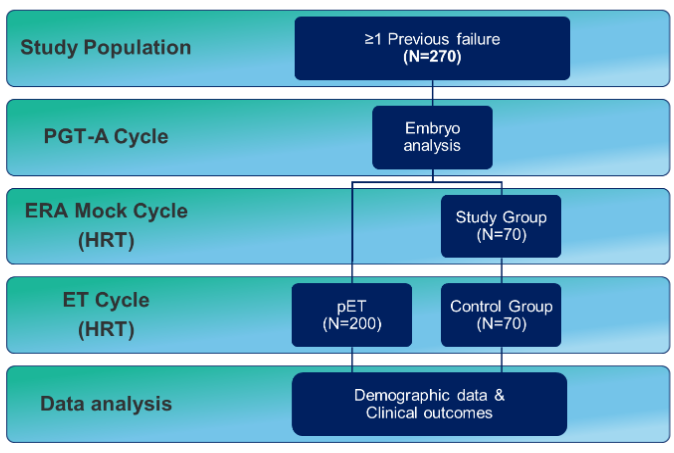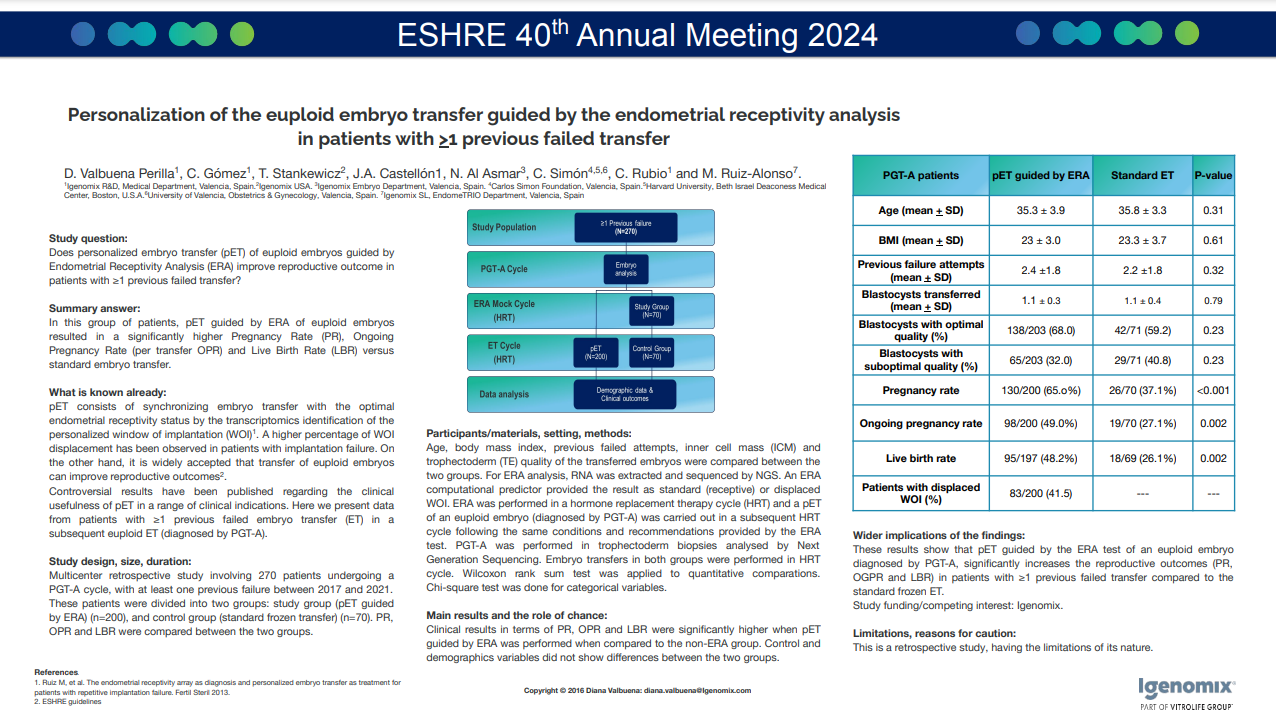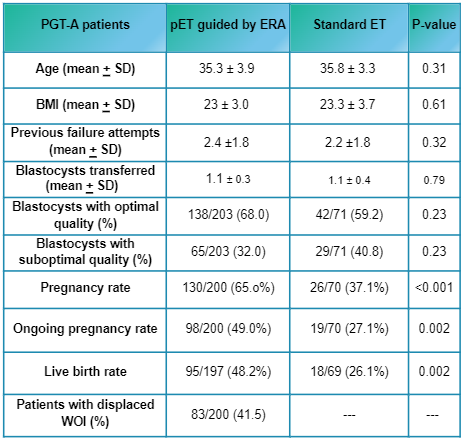Personalization of the euploid embryo transfer guided by the endometrial receptivity analysis in patients with >1 previous failed transfer.
D. Valbuena Perilla1, C. Gómez1, T. Stankewicz2, J.A. Castellón1, N. Al Asmar3, C. Simón4,5,6, C. Rubio1 and M. Ruiz-Alonso7.
1Igenomix R&D, Medical Department, Valencia, Spain.2Igenomix USA. 3Igenomix Embryo Department, Valencia, Spain. 4Carlos Simon Foundation, Valencia, Spain.5Harvard University, Beth Israel Deaconess Medical Center, Boston, U.S.A.6University of Valencia, Obstetrics & Gynecology, Valencia, Spain. 7Igenomix SL, EndomeTRIO Department, Valencia, Spain
Study question:
Does personalized embryo transfer (pET) of euploid embryos guided by Endometrial Receptivity Analysis (ERA) improve reproductive outcome in patients with ≥1 previous failed transfer?
Summary answer:
In this group of patients, pET guided by ERA of euploid embryos resulted in a significantly higher Pregnancy Rate (PR), Ongoing Pregnancy Rate (per transfer OPR) and Live Birth Rate (LBR) versus standard embryo transfer.
What is known already:
pET consists of synchronizing embryo transfer with the optimal endometrial receptivity status by the transcriptomics identification of the personalized window of implantation (WOI)1. A higher percentage of WOI displacement has been observed in patients with implantation failure. On the other hand, it is widely accepted that transfer of euploid embryos can improve reproductive outcomes2.
Controversial results have been published regarding the clinical usefulness of pET in a range of clinical indications. Here we present data from patients with ≥1 previous failed embryo transfer (ET) in a subsequent euploid ET (diagnosed by PGT-A).
Study design, size, duration:
Multicenter retrospective study involving 270 patients undergoing a PGT-A cycle, with at least one previous failure between 2017 and 2021. These patients were divided into two groups: study group (pET guided by ERA) (n=200), and control group (standard frozen transfer) (n=70). PR, OPR and LBR were compared between the two groups.
Participants/materials, setting, methods:
Age, body mass index, previous failed attempts, inner cell mass (ICM) and trophectoderm (TE) quality of the transferred embryos were compared between the two groups. For ERA analysis, RNA was extracted and sequenced by NGS. An ERA computational predictor provided the result as standard (receptive) or displaced WOI. ERA was performed in a hormone replacement therapy cycle (HRT) and a pET of an euploid embryo (diagnosed by PGT-A) was carried out in a subsequent HRT cycle following the same conditions and recommendations provided by the ERA test. PGT-A was performed in trophectoderm biopsies analysed by Next Generation Sequencing. Embryo transfers in both groups were performed in HRT cycle. Wilcoxon rank sum test was applied to quantitative comparations. Chi-square test was done for categorical variables.
Main results and the role of chance:
Clinical results in terms of PR, OPR and LBR were significantly higher when pET guided by ERA was performed when compared to the non-ERA group. Control and demographics variables did not show differences between the two groups.

Wider implications of the findings:
These results show that pET guided by the ERA test of an euploid embryo diagnosed by PGT-A, significantly increases the reproductive outcomes (PR, OGPR and LBR) in patients with ≥1 previous failed transfer compared to the standard frozen ET.
Study funding/competing interest: Igenomix.
Limitations, reasons for caution:
This is a retrospective study, having the limitations of its nature.
Copyright © 2016 Diana Valbuena: diana.valbuena@Igenomix.com




